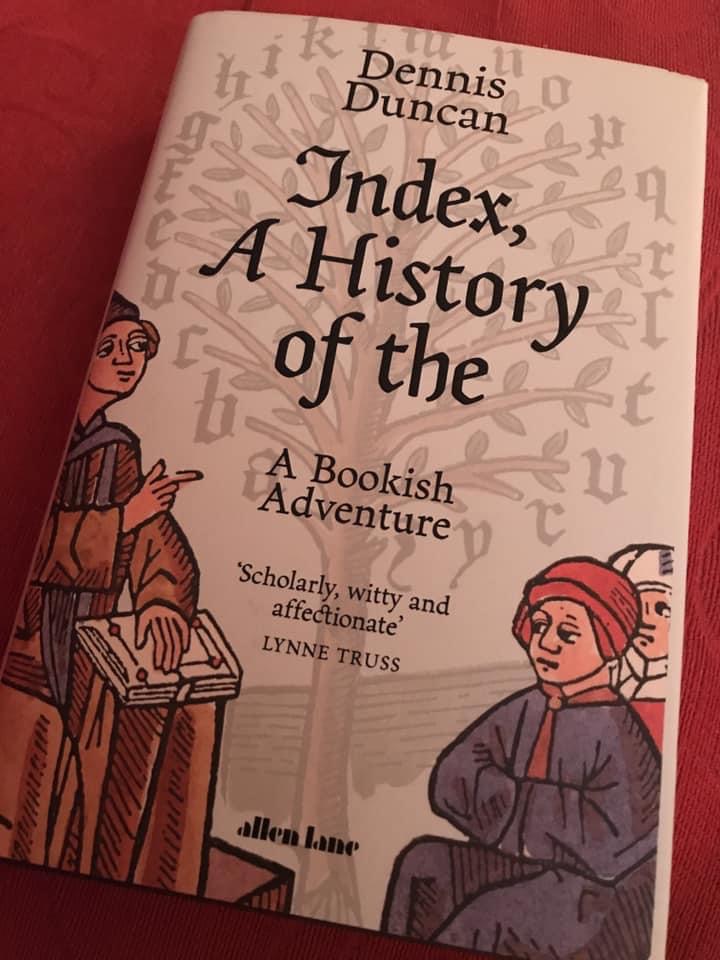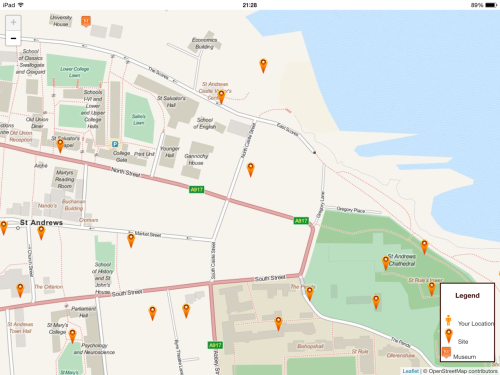This week has been graduation week at St Andrews. But the university has also been hosting a conference: The Middle Ages in the Modern World, whose subtitle is ‘A multidisciplinary conference on medievalism in the post-Middle Ages’.

Middle Ages conference programme
Now the Middle Ages isn’t my main research period, indeed it’s one I don’t know much about at all. But it’s an interesting theme for a conference, and there were enough intriguing looking talks for me to sign up as a delegate. Coming over from Dundee the conference was almost on my doorstep, only half an hour away from home. It seemed daft to miss it. Also St Andrews seems like a perfect venue for a conference on this, given its rich history, including being a centre for learning since the Middle Ages, and its many medieval buildings, both intact and those, like the Cathedral and Castle, more ruined.

St Andrews Cathedral ruins
Unfortunately I couldn’t attend very much of it due to my MS-like illness. The conference runs over three full days, plus a plenary talk on the day before then. But I couldn’t ever hope to do successive days now. In the end I aimed for the plenary on the Tuesday, then would rest on the Wednesday, before coming back for much of the Thursday, and resting again (and missing) the Friday talks.
I’d arranged in advance for my husband to attend free as my carer and wheelchair pusher. He would be bored, but was essential if I was going to get through the time there. Although I don’t usually use my wheelchair I find now that when I attend an academic conference, and have the combination of needing to keep my brain in gear and juggle moving around for different panels and things, all for many hours, the wheelchair lets me keep going for longer, and thus stay and participate in the conference for longer too. We had a few hiccups with the disability support when we turned up to register for the conference on Tuesday, but they were eventually all sorted out. The best help of all came from a university porter at College Gate on North Street, who despite the closed-off university grounds and parking due to graduation waved us through, and walked us round to a suitable parking space, right near the Younger Hall where Terry Jones’s plenary was taking place later that day.
We killed time until the talk by wheeling along to the university’s Main Library, where there’s now a very comfortable cafe, that kept me topped up with hot chocolate, while I worked on an academic paper on my iPad and my husband read. I’d printed a floorplan of the library before travelling. It was renovated recently, and I’ve been a bit bamboozled by the new layout. It has changed enormously from the library I knew from 1990 onwards. My husband and I are life graduate members of St Andrews university library, and could have gone into the main area to sit at study desks, but it was more comfortable to kill time in the new library cafe with informal seating and hot drinks machines nearby.
Terry Jones’s plenary talk was being put on as a joint conference opening plenary and lecture to celebrate the university’s 600th anniversary. It was held in the Younger Hall, where I graduated with my husband in 1994, and there was a large audience of conference delegates – who got the good seats at the front – and other members of the public. The principal, Louise Richardson, introduced the speaker, and then he spoke for about 45 minutes on ‘Columbus, America and the Flat Earth’. Overall it was a very well presented talk: funny, educational, and challenging at the same time. It also had, appropriately, a very Pythonesque series of PowerPoint slides, making hilarious use of pop-up speech bubbles. And he got away with a very risque picture at the end. As the principal commented afterwards, it was unlikely that any picture like that had ever been shown in that venue before! It was thoroughly entertaining, and the appreciative audience enjoyed it immensely.
We’d booked a meal in my favourite restaurant, but because the plenary finished very promptly we were able to nip round first to a former computer science lecturer of mine’s home, and have a cup of tea and a chat and catchup with him, which was really nice. And then the restaurant meal was as good as expected.
Sadly of course I had to miss the Wednesday talks. That included a panel on furniture and furnishings, including a talk on the 18th century, that I had been really keen to go to, but then it was moved at a late stage in the programme from Thursday afternoon to Wednesday afternoon. Drat! And I knew I was also going to miss two other talks on the Friday that would have really appealed to me: one about representing the Middle Ages in computer strategy games, and another about weird fiction of M.R. James. Drat again! Still couldn’t be helped.
So rest (actually sleep all night and day) on the Wednesday, then back on the Thursday. We missed the opening plenary, to keep things manageable for me, and turned up around 10.30. The main conference is at the Gateway building at the North Haugh, not far from where my husband and I were science undergraduates in the early 1990s. I hadn’t been back to the North Haugh since I left my full-time computer science PhD in 1996, as my developing neurological illness got too much to battle on with. So it was quite a big thing for me to be back in the area. The Gateway centre is nice: modern, with some good facilities. But there were downsides as a wheelchair user. The lifts are tight if you are in a wheelchair, and I couldn’t have managed them on my own. And there are also lots of doors to negotiate, again something I couldn’t have managed without help. Also from the perspective of a conference venue we found, in theatre 3, that there was a lot of sound coming through from theatre 4 next door, and from the kitchen. Sound proofing in the building does not seem as good as it should be.
On the plus side I really enjoyed my time on Thursday. In the end I only stayed for two panels. Had the furniture panel still been on in the last slot I’d have hung on for that, but as it was it was better to head off before I got too weak. The first panel I went to was on Arthuriana in the Modern World, and included discussions of the Once & Future King, Tolkien’s epic poem Fall of Arthur, and some German Arthurian texts. All were enjoyable, and all prompted me to check what books I have on my Kindle (already Fall of Arthur, going to buy Once & Future King to reread, and bought an English version of medieval romance Parzival).
Lunch followed, and was tasty and well organised, and provided a welcome break before the afternoon panel. It also gave me a chance to look through the book Treasures of St Andrews University Library which I’d bought at a discount in the morning. I was particularly intrigued to read about the library borrowing records they hold, because I studied lots of such records for my history PhD investigating reading habits. And I also spotted that they have three manuscripts of Sir Isaac Newton, so immediately texted my physicist Dad to tell him!

Treasures of St Andrews University Library
The final panel I went to was on Modern War and the Medieval Past. I particularly liked Carol Symes’s talk about the Middle Ages of World War I, including the ways in which the Middle Ages was used by the various sides in propaganda. This was well illustrated and used PowerPoint well, showing us posters, postcards, photos and news reports from the time. Thoroughly well done. And then I also enjoyed Andrew Lynch’s talk about the Medieval in Children’s Histories of England. Though on the downside he declared up front that he was talking about four histories: one from the 18th century, two from the 19th, and one from the early 20th. In the end he only really talked about the 19th century ones, which for me as an 18th century book historian was a pity. But I can always try to get a copy of Oliver Goldsmith’s children’s history – another for the Kindle!
We headed off after that. I was quite weak by this stage, and it was better to head home. We took the chance to look at the museum exhibits on the ground floor of the Gateway, before driving round to Jannetta’s ice cream parlour, to have a treat, and use the 10% discount voucher I had from the conference (great idea organisers: thanks!). 52 flavours to choose from, which is really hard, but I plumped for some wacky ones: a 2-scoop tub of spiced peach and hazelnut ice cream. Was good, and served with a wafer.

Ice cream from Jannettas
Tonight the delegates are dining at University Hall, which the conference programme describes as a “turreted, gothic confection of a building”. I stayed there in 1990-1991, and that description just about sums it up, at least the older prettier bits. Lucky diners!
Am I glad that I went? Yes, though I wish I could have gone to more events, and I wish I could have attended some of the other talks I was interested in, particularly the panel whose day was moved. But I had to compromise, and I think I found enough things of interest to me. I also found the talks that I attended well aimed, so they would appeal to both specialists and general (like me) audience members. And my Kindle now has many more books to read. So thanks very much to the organisers, speakers and fellow delegates.
Read Full Post »











